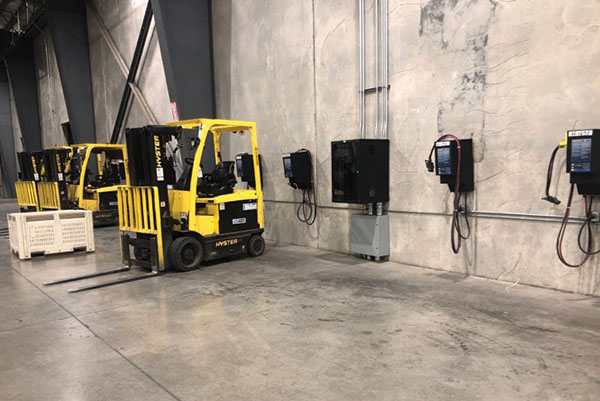Li-ion technology enhances fleet effectiveness
Lithium-ion lift truck batteries help food producer save more than half a million dollars.
Allan Brothers, a century-old vertically integrated fruit company, manages its own farm acreage, growing apples, cherries and wine grapes. With 600 full-time employees and 2,500 workers during peak harvest season, the operation also packages and ships its fruit, along with third-party fruit, to locations across the United States, Canada, Mexico and other countries.
In 2018, as the company prepared to install a new state-of-the-art fruit packing line—which it claims is the biggest in the world—management realized the costs associated with lead acid battery-powered electric lift trucks were adding up. Time spent changing batteries during shifts was costing $56,000 a year and another $7,800 a year in watering maintenance costs. What’s more, the expansion required a new battery room estimated to cost another $440,000.
With a fleet of 30 lift trucks working two shifts, each required a battery change per shift. Forklift drivers also operated the battery-changing crane and watered the batteries. Managers figured maintenance caused 750 minutes of downtime daily. At the same time, the business was deciding on the next lease term for its lift trucks. By equipping its fleet with Li-ion batteries (OneCharge), the company saved on ongoing maintenance costs while reducing the investment needed for the 300,000-square-foot expansion.
Li-ion spared the expense of a battery room and battery changing, but it also improved lift truck efficiency as a result of better battery performance. Managers also valued the enhanced safety, eliminating the need for employees to work with lead acid batteries and improving conditions for the company’s food product lines. The reduced health risks meant lower insurance rates for all 30 lift truck operators, totaling $6,000 in savings per year.
Batteries plugged in overnight are completely charged by the start of a shift at 3 a.m. The fleet also uses opportunity charging during 15-minute breaks and 30-minute lunch breaks. The batteries continue to operate at close to 100% of the original capacity throughout shifts. The company’s lead acid batteries had gradually decreased in power, slowing down by at least 20% over time.
Because Li-ion batteries can run for more than 3,000 cycles, compared to an average of 1,500 for lead acid, Allan Brothers also expects longer battery life. Management says it’s likely the batteries will outlast the current five-year lease term for its lift trucks. When new leases are signed, the company anticipates reduced prices as damage to the trucks from daily battery changes and corrosive acid spills are no longer a factor. The company expects to cut battery costs by 20% to 40% within two years.

Article Topics
Lift Trucks News & Resources
BSLBATT is looking for new distributors and resellers worldwide Hyster recognizes Dealers of Distinction for 2023 Carolina Handling names Joe Perkins as COO Toyota Material Handling North America appoints Mark Taggart as CFO Learn from lift truck service history Toyota Material Handling honors its top forklift dealers in North America Fleet Team expands with strategic acquisition of Forklift Training Systems More Lift TrucksLatest in Materials Handling
Beckhoff USA opens new office in Austin, Texas Manhattan Associates selects TeamViewer as partner for warehouse vision picking ASME Foundation wins grant for technical workforce development The (Not So) Secret Weapons: How Key Cabinets and Asset Management Lockers Are Changing Supply Chain Operations MODEX C-Suite Interview with Harold Vanasse: The perfect blend of automation and sustainability Consultant and industry leader John M. Hill passes on at age 86 Registration open for Pack Expo International 2024 More Materials HandlingAbout the Author
Subscribe to Materials Handling Magazine

Find out what the world's most innovative companies are doing to improve productivity in their plants and distribution centers.
Start your FREE subscription today.
April 2024 Modern Materials Handling

Latest Resources












